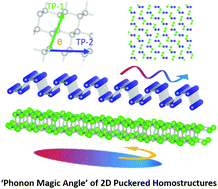Phonon magic angle in two-dimensional puckered homostructures†
Abstract
The emergence of twistronics provides an unprecedented platform to modulate the band structure, resulting in exotic electronic phenomena ranging from ferromagnetism to superconductivity. However, such a concept in phonon engineering is still lacking. Here, we extend ‘twistnonics’ to 2D puckered materials with a ‘phonon magic angle’ discovered by molecular dynamics simulation. Based on studies of two typical 2D puckered materials, BP and SnSe, we found that the phonon magic angle, with the TP-1 and TP-2 directions overlapped, retains a high level or even an enhanced level of phonon transport capability due to van der Waals (vdW) confinement. This novel phenomenon originates from the confined vdW potential energy and weak phonon anharmonicity caused by the perfect lattice arrangement in which the atoms of the top layer can be stuck to the spaces of the bottom layer. Moreover, it is found that both the in-plane and out-of-plane thermal transport properties can be effectively regulated by applying the twist. Through phononic and electronic analysis, the deterioration in phonon transport capability for other twist angles are attributed to the suppression of acoustic phonon modes, reduction in phonon lifetimes and mismatched lattice vibration between layers. Our findings shed light on the twistnonics of low-dimensional asymmetrical materials and can be further extended to electronic and photonic devices.



 Please wait while we load your content...
Please wait while we load your content...